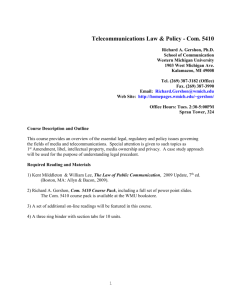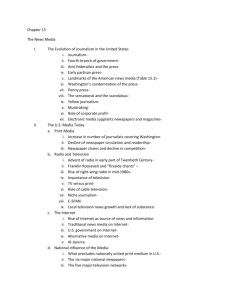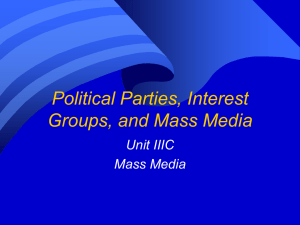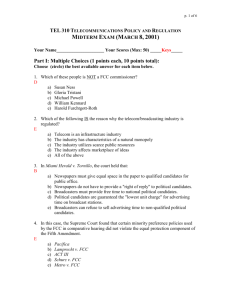CONTENTS
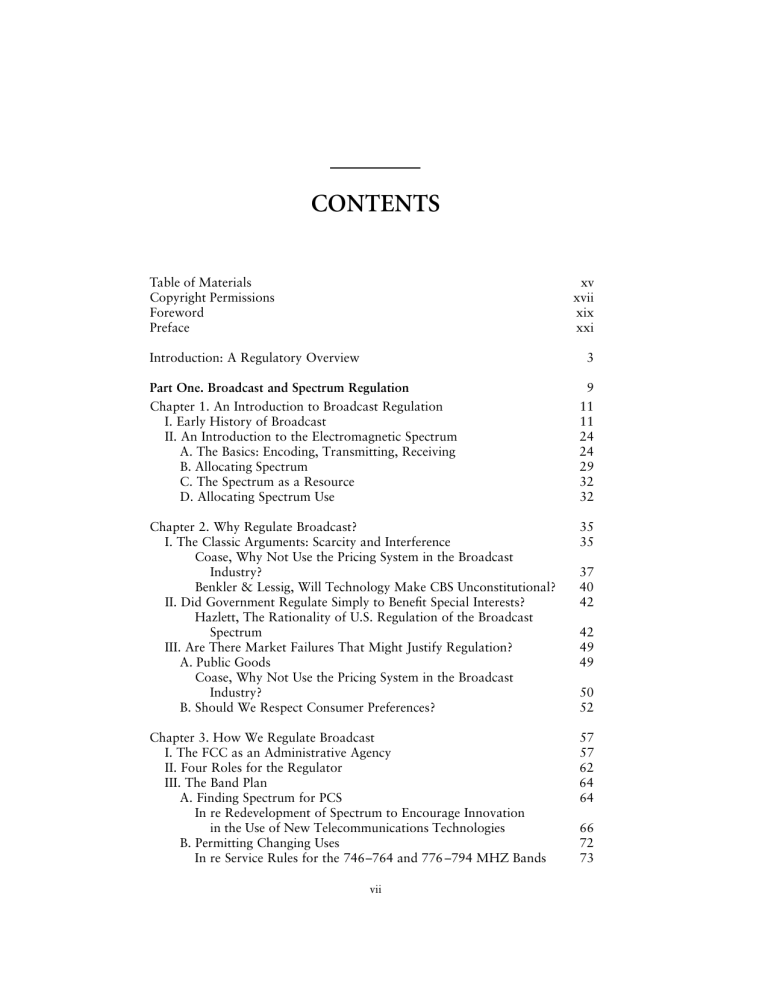
CONTENTS
Table of Materials
Copyright Permissions
Foreword
Preface
Introduction: A Regulatory Overview
Part One. Broadcast and Spectrum Regulation
Chapter 1. An Introduction to Broadcast Regulation
I. Early History of Broadcast
II. An Introduction to the Electromagnetic Spectrum
A. The Basics: Encoding, Transmitting, Receiving
B. Allocating Spectrum
C. The Spectrum as a Resource
D. Allocating Spectrum Use
Chapter 2. Why Regulate Broadcast?
I. The Classic Arguments: Scarcity and Interference
II. Did Government Regulate Simply to Benefit Special Interests?
Hazlett, The Rationality of U.S. Regulation of the Broadcast
35
35
Coase, Why Not Use the Pricing System in the Broadcast
Industry? 37
Benkler & Lessig, Will Technology Make CBS Unconstitutional? 40
42
Spectrum
III. Are There Market Failures That Might Justify Regulation?
A. Public Goods
Coase, Why Not Use the Pricing System in the Broadcast
42
49
49
Industry?
B. Should We Respect Consumer Preferences?
50
52
Chapter 3. How We Regulate Broadcast
I. The FCC as an Administrative Agency
II. Four Roles for the Regulator
III. The Band Plan
A. Finding Spectrum for PCS
In re Redevelopment of Spectrum to Encourage Innovation in the Use of New Telecommunications Technologies
B. Permitting Changing Uses
In re Service Rules for the 746–764 and 776 –794 MHZ Bands
57
57
62
64
64
66
72
73 xv xvii xix xxi
3
9
11
11
24
24
29
32
32 vii
viii CONTENTS
Chapter 4. License Hearings at the FCC (1934–1998)
I. Initial Assignment Hearings
In re H.E. Studebaker
In re Charles Henry Gunthorpe, Jr.
II. Comparative Hearings
A. Basic Comparative Licensing Criteria
FCC Policy Statement on Comparative Broadcast Hearings
B. Special Considerations for Racial Minorities and Women i. Minority Preferences (PreAdarand )
Metro Broadcasting, Inc. v. FCC ii. Preferences for Women iii. Adarand ( Metro Broadcasting Overruled) iv. Equal Employment Opportunity Regulations
Lutheran Church-Missouri Synod v. FCC
III. License Renewal for Incumbents
Citizens Communications Center v. FCC
Central Florida Enterprises v. FCC
IV. License Transfers
Changes in the Entertainment Formats of Broadcast Stations
WNCN Listeners Guild v. FCC
FCC v. WNCN Listeners Guild
V. Licensing Case Study
In re Application of Simon Geller
Chapter 5. The Transition from Hearings to Auctions
I. Reform of the Licensing Process
In re Prevention of Abuses of the Renewal Process
II. Lotteries, Auctions, and Comparative Hearings
III. Initial Assignment by Auction
In re Implementation of Section 309(j) of the
Communications Act
Chapter 6. The Licensee as Public Trustee
I. The Fairness Doctrine and Related Obligations
A. The Fairness Doctrine
Miami Herald Publishing Co. v. Tornillo
Red Lion Broadcasting Co. v. FCC
Fairness Doctrine Report
In re Complaint of Syracuse Peace Council
B. The Personal Attack and Political Editorial Rules
C. Political Broadcasting
In re Request of ABC, Inc. for Declaratory Ruling
In re Request for Declaratory Ruling of National
Association of Broadcasters Regarding Section 312(a)(7) of the Communications Act
In re Petition for Reconsideration by People for the American
Way and Media Access Project of Declaratory Ruling
Regarding Section 312(a)(7) of the Communications Act
II. Indecent Broadcasts
139
140
140
144
146
147
157
159
159
159
161
168
180
187
189
190
90
90
101
102
103
104
111
113
85
86
86
90
81
82
82
83
116
122
124
126
129
132
132
196
199
204
CONTENTS
FCC v. Pacifica Foundation
In re Pacifica Foundation [ Jerker ]
Action for Children’s Television v. FCC [ Act III ]
III. Televised Violence
Balkin, Media Filters, the V-Chip, and the Foundations of
Broadcast Regulation
IV. Children’s Television
In re Children’s Television Programming and Advertising
204
215
220
239
242
254
Practices
Policies and Rules Concerning Children’s Television
Programming (1991)
Policies and Rules Concerning Children’s Television
255
260
Programming (1996) 263
V. Commercialization, Ascertainment, and Other Commission Rules 279
In re Deregulation of Commercial Television 279
Chapter 7. Fostering Competition in Broadcasting
I. The Television Networks
A. Network Dominance
Besen et al., Misregulating Television
B. The Network/Affiliate Relationship
Besen et al., Misregulating Television
C. The Network/Program Supplier Relationship
Schurz Communications v. FCC
II. Ownership Restrictions
Biennial Report, Review of the Commission’s Broadcast Rules and Other Rules Adopted Pursuant to Section 202 of the
Telecommunications Act of 1996
289
290
290
291
297
298
302
304
313
314
Chapter 8. Case Studies in Low Power FM Radio and
Digital Television
I. Low Power FM Radio
II. Digital Television
A. Making Room for HDTV
In re Advanced Television Systems (1991)
B. Choosing a Standard
In re Advanced Television Systems (1996)
C. Services Required and Permissible on Spectrum Given to Broadcasers for DTV
In re Advanced Television Systems (1997)
D. Public Interest Obligations
Final Report of the Advisory Committee on Public Interest
Obligations of Digital Television Broadcasters
Part Two. Cable Television
Chapter 9. Cable Basics and the Early History
I. Introduction
II. The Problem of Natural Monopoly
III. Early Regulatory Responses to Cable
325
325
332
333
334
340
341
351
351
360
361
369
371
371
374
380 ix
x CONTENTS
Besen & Crandall, The Deregulation of Cable Television
Home Box Office (HBO) v. FCC
IV. The Jurisdiction Puzzle: Who Should Regulate?
Group W Cable, Inc. v. City of Santa Cruz
Chapter 10. Rate Regulation and Local Franchise Authority
I. Rate Regulation
Rate Regulation of Cable Services
Note on Rate Regulation
II. Local Franchise Agreements
Time Warner Entertainment Co. v. FCC
Rate Regulation of Cable Service
Chapter 11. The Broadcast/Cable Relationship
I. Copyright and Compulsory Licenses
II. Syndicated Exclusivity and Network Nonduplication
United Video v. FCC
III. Must-Carry and Retransmission Consent
Turner Broadcasting System, Inc. v. FCC [ Turner I ]
Turner Broadcasting System, Inc. v. FCC [ Turner II ]
Chapter 12. Structural Limitations
I. Protecting Program Suppliers
A. Controls on Vertical Integration
Implementation of Section 11 of the Cable Television
Consumer Protection and Competition Act of 1992
B. Controls on Horizontal Concentration
Implementation of Section 11(c) of the Cable Television
Consumer Protection and Competition Act of 1992
Judicial Review
II. Regulation of Program Supply Contracts
Development of Competition and Diversity in Video
Programming Distribution and Carriage
Chapter 13. Direct Broadcast Satellite
I. The Primetime Litigation
CBS Broadcasting v. Primetime 24
II. The Satellite Home Viewer Improvement Act of 1999
The Satellite Television Act of 1999
Note on the SHVIA
III. Requiring Educational Programming on DBS
Time Warner Entertainment Co. v. FCC (1996)
Time Warner Entertainment Co. v. FCC (1997)
Chapter 14. Indecency Revisited
Cruz v. Ferre
Denver Area Educational Telecommunications Consortium,
Inc. v. FCC
United States v. Playboy Entertainment Group, Inc.
499
500
501
501
508
441
442
445
446
453
456
474
380
391
399
400
413
413
414
425
429
431
438
508
522
525
525
541
544
544
550
551
553
557
558
561
567
567
570
588
CONTENTS
Part Three. Telephone Regulation
Chapter 15. An Introduction to Telephone Regulation
I. Telephone System Basics
A. The Early History
Huber et al., Federal Telecommunications Law
B. Federal Versus State Regulation
C. Telephone System Vocabulary
II. Telephony as a Monopoly Service
Note on Ramsey Pricing
III. Precursors to Divestiture
A. Competition in Customer Premises Equipment
Huber et al., Federal Telecommunications Law
B. Competition in the Long Distance Market
Robinson, The Titanic Remembered: AT&T and the Changing
World of Telecommunications
C. Communications/Computer Convergence
Robinson, The Titanic Remembered: AT&T and the Changing
World of Telecommunications
D. Rate-of-Return Regulation
In the Matter of Policy and Rules Concerning Rates for
Dominant Carriers
Chapter 16. Breakup of the Bell Monopoly
I. Introduction
II. The Modification of Final Judgment (MFJ)
United States v. American Telephone & Telegraph Co.
Note on the Government’s Theory
III. Antitrust Theories Underlying the MFJ
Noll & Owen, The Anticompetitive Uses of Regulation: United
States v. AT&T
Chapter 17. Issues Post-Divestiture
I. Rate Regulation in a Post-Divestiture World
In re Policy & Rules Concerning Rates for Dominant Carriers
II. The BOC “Line of Business” Restrictions
A. An Overview of the Restrictions
Robinson, The Titanic Remembered: AT&T and the Changing
World of Telecommunications
B. Judicial Review of the Restrictions i. The Consent Decree
United States v. Western Electric Co. (1990)
United States v. Western Electric Co. (1993) ii. FCC Rules Independent of the Decree
California v. FCC [ Computer III ]
III. Universal Service after Divestiture
Chapter 18. The Telecommunications Act of 1996
I. The Local Competition Provisions
691
693
693
693
700
704
704
712
715
717
664
681
682
683
691
691
629
632
633
635
636
641
641
643
643
661
664
603
605
605
605
607
610
613
614
621
623
624
624
628 xi
xii CONTENTS
In re Implementation of the Local Competition Provisions of the Telecommunications Act Of 1996
AT&T Corporation v. Iowa Utilities Board
Note on Jurisdiction
In re Implementation of the Local Competition Provisions of the Telecommunications Act of 1996
Note on the Pricing of Network Elements
Iowa Utilities Board v. FCC
Note on Interconnection
In re Implementation of the Local Competition Provisions of the Telecommunications Act of 1996
II. BOC Line of Business Restrictions Under the Act
AT&T Corporation v. FCC
SBC Communications, Inc. v. FCC
III. Universal Service and Access Charge Reform
FCC News Release: Joint Board Adopts Universal Service
Recommendations
In re Federal-State Joint Board on Universal Service
In re Access Charge Reform
Chapter 19. Mergers and Acquisitions
I. Background
II. The SBC/Ameritech Proceeding
In re Applications of Ameritech Corp., Transferor, and SBC
Communications, Inc., Transferee, for Consent to Transfer
Control of Licenses and Lines Pursuant to Sections 214 and
310(D) of the Communications Act
Separate Statement of Commissioner Harold Furchtgott-Roth,
Concurring in Part, Dissenting in Part
Statement of Commissioner Michael K. Powell, Concurring in
Part, Dissenting in Part
III. Merger Reform
Statement of Chairman William E. Kennard
Statement of Commissioner Harold Furchtgott-Roth
Part Four. The Internet and Advanced Services
Chapter 20. The Internet and its Regulation
I. The History and Architecture of the Internet
II. Regulation of the Internet
A. The Principles of Internet (Un)Regulation
Clinton Administration, A Framework for Global Electronic
Commerce
B. Content Regulation i. Indecent Communication via Telephone
Sable Communications of California, Inc. v. FCC
In re Regulations Concerning Indecent Communications by
Telephone ii. Indecent Communication over the Internet
Reno v. ACLU
751
755
758
762
768
771
773
784
719
725
731
735
740
743
749
793
794
797
797
807
814
817
818
820
825
827
828
835
837
837
839
839
839
845
848
848
CONTENTS xiii
Chapter 21. Advanced Services and Internet Architecture
I. An Introduction to Advanced Services
A. The FCC’s Implementation of Section 706
Inquiry Concerning the Deployment of Advanced
Telecommunications
B. Regulatory Alternatives
II. Unbundled Access to Telephone System Infrastructure
In the Matter of Implementation of the Local Competition
Provisions of the Telecommunications Act of 1996
Notes and Questions
In the Matters of Deployment of Wireline Services Offering
Advanced Telecommunications Capability and
Implementation of the Local Competition Provisions of the
Telecommunications Act of 1996
III. Open Access to Cable System Infrastructure
AT&T v. City of Portland
867
867
868
868
878
880
881
885
886
892
895
Inquiry Concerning High-Speed Access to the Internet over
Cable and Other Facilities
Rogerson, The Regulation of Broadband Telecommunications, the Principle of Regulating Narrowly Defined Input
901
Bottlenecks, and Incentives for Investment and Innovation
IV. Non-Regulation of the Internet Backbone: Peering and Transit
912
Arrangements 915
Kende, The Digital Handshake: Connecting Internet Backbones 916
Chapter 22. Characterizing Internet Service Providers
I. Access Charges and Reciprocal Compensation
In the Matter of Access Charge Reform
In re Implementation of the Local Competition Provisions in the Telecommunications Act of 1996, Inter-Carrier
Compensation for ISP-Bound Traffic
Bell Atlantic Telephone Company v. FCC
II. Internet Protocol Telephony
In the Matter of the Federal-State Joint Board on Universal
Service
927
930
931
935
941
945
946
Chapter 23. Why an FCC?
A New Federal Communications Commission for the 21st
Century
Huber, Abolish the FCC and Let Common Law Rule the
Telecosm
Sunstein, The First Amendment in Cyberspace
Krattenmaker & Powe, Converging First Amendment Principles for Converging Communications Media
951
952
956
963
969
Statutory Appendix
Conceptual Index and Telecommunications Glossary
979
1045
